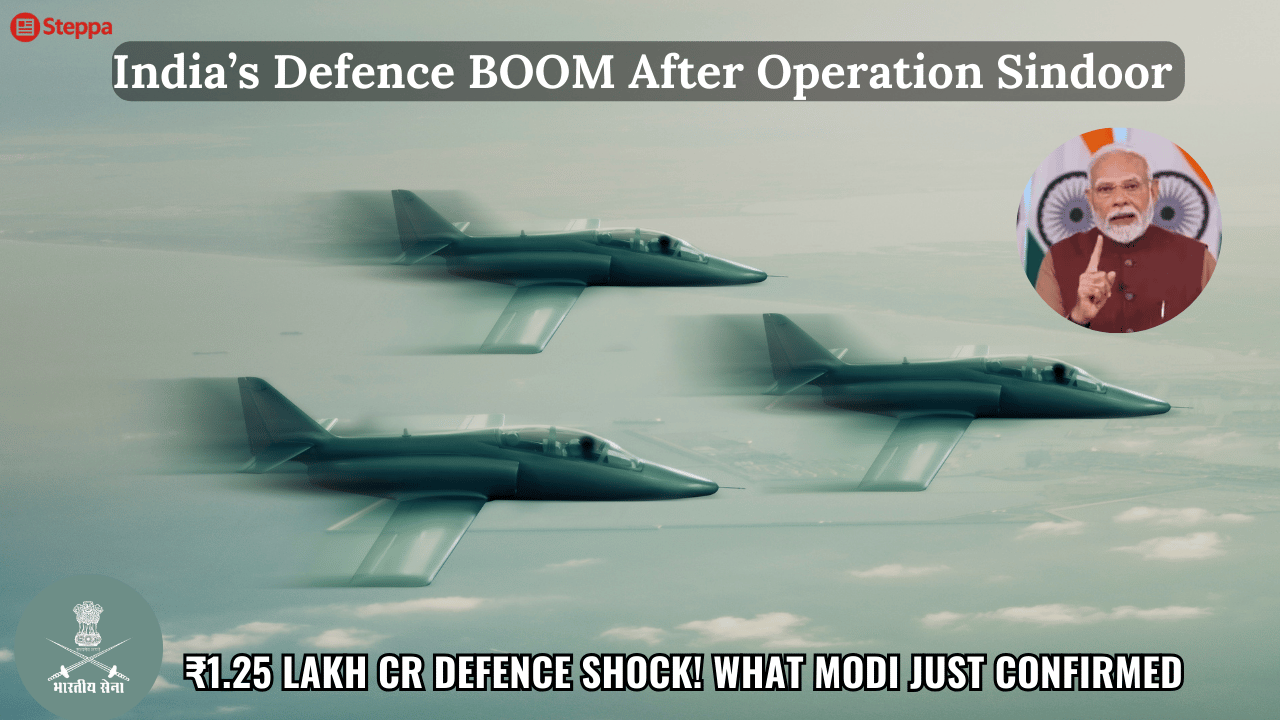India’s homegrown defence sector just got a massive vote of confidence—and it’s not just about tanks or missiles anymore. Prime Minister Narendra Modi, addressing the nation, confirmed that Operation Sindoor has become a major turning point in India’s defence landscape, pushing the country’s indigenous defence manufacturing to an all-time high.
“There is a lot of discussion of defence manufacturing after Operation Sindoor… Our defence production has crossed ₹1.25 lakh crore,” PM Modi stated, as quoted by ANI.
This announcement comes as part of India’s growing focus on self-reliance in defence manufacturing—a mission Modi’s government has championed under the ‘Atmanirbhar Bharat’ push.
What Is Operation Sindoor—And Why Is Everyone Talking About It?
Let’s break it down. While the government hasn’t shared every classified detail, Operation Sindoor has been touted as a highly successful strategic military operation that showcased India’s technological, logistical, and combat readiness. And more importantly, it exposed the growing confidence in weapons and tech made right here in India.
Defence insiders say this operation wasn’t just about boots on the ground—it was about showing off homegrown tech that could match (or outpace) global standards. That message wasn’t lost on the global stage or investors, as India’s defence production pipeline is now hotter than ever.
₹1.25 Lakh Crore: Not Just a Number, But a Statement
Crossing the ₹1.25 lakh crore mark in defence production isn’t just good news—it’s symbolic. It tells the world that India’s shift from a buyer of defence systems to a manufacturer and exporter is very real.
This surge includes a wide range of defence products:
- Combat drones
- Advanced surveillance systems
- Indigenous artillery and missile systems
- Tactical vehicles
- Naval shipbuilding
- Small arms and protective gear
Several of these were reportedly field-tested or deployed during Operation Sindoor, which added weight to India’s defence credibility.
Why This Matters Right Now
India has long been one of the world’s top importers of military hardware. But things are changing. With growing border tensions, regional rivalries, and geopolitical shifts, self-sufficiency isn’t just a slogan—it’s survival.
The push for local production ensures faster deployment, lower costs, and most importantly, less reliance on foreign governments—some of which may impose restrictions or play politics.
The success of Operation Sindoor has provided the perfect PR boost to back that strategy.
Modi Govt’s Bet on Atmanirbhar Bharat: Paying Off?
The Atmanirbhar Bharat defence initiative has come under plenty of scrutiny over the years, with critics calling it slow, idealistic, or overly ambitious. But with this new production milestone, the tables may be turning.
Notably, the Modi government has:
- Banned the import of over 400 defence items.
- Increased budget allocations for R&D in defence.
- Offered incentives to private players via the Defence Production and Export Promotion Policy (DPEPP).
- Opened doors for 100% FDI in defence manufacturing (up to 74% through automatic route).
- Pushed DRDO to co-develop and co-produce advanced tech with Indian firms.
And now, with concrete numbers in hand, those efforts seem to be delivering results.
What Defence Analysts Are Saying
Defence experts see Operation Sindoor as more than just a military success. It’s also been a marketing masterstroke for India’s defence capabilities.
“India didn’t just win a tactical battle. We’ve proved to the world that we can deploy weapons designed, built, and tested right here at home,” said a senior official close to the operation, requesting anonymity due to security protocol.
Others pointed to how this milestone could attract more international interest in buying Indian weapons, drones, and surveillance tools.
The Road Ahead
Will this pace continue? Honestly, that depends. The upcoming defence budget will be a big indicator. If the government continues pushing for domestic procurement, India could soon enter the top 5 global arms exporters club.
PM Modi has already hinted that the goal isn’t just production for India—but exports that reshape the global arms trade.
FAQs: What You Should Know
Q1: What is Operation Sindoor?
It’s a recent military operation showcasing India’s indigenous defence capabilities. While classified in detail, it’s seen as a turning point for India’s military tech.
Q2: What did PM Modi announce?
He confirmed India’s defence manufacturing has crossed ₹1.25 lakh crore, crediting Operation Sindoor for this momentum.
Q3: Why is this milestone important?
It signals India’s transition from a defence importer to a credible manufacturer and possible exporter.
Q4: Which items contributed to this production value?
Combat drones, missile systems, small arms, tactical vehicles, and naval equipment are among the major contributors.
Q5: How does this help India’s military?
It boosts self-reliance, ensures quick availability of equipment, and reduces dependency on foreign suppliers.
Q6: What’s the government’s role in all this?
Through policies like DPEPP and Atmanirbhar Bharat, the government has given big pushes to R&D and private sector participation.
Q7: Will India start exporting more defence equipment?
That’s the goal. With this milestone, India is likely to attract international buyers for its indigenous tech.
Q8: Does this affect India’s position globally?
Yes. A strong indigenous defence industry boosts diplomatic leverage, regional strength, and long-term security.
Q9: How are private companies involved?
Major firms like Tata Advanced Systems, Bharat Forge, L&T, and Adani Defence are actively building and co-developing defence equipment.
Q10: What happens next?
We can expect more operations testing homegrown tech, continued policy pushes, and possibly new export deals with friendly nations.
